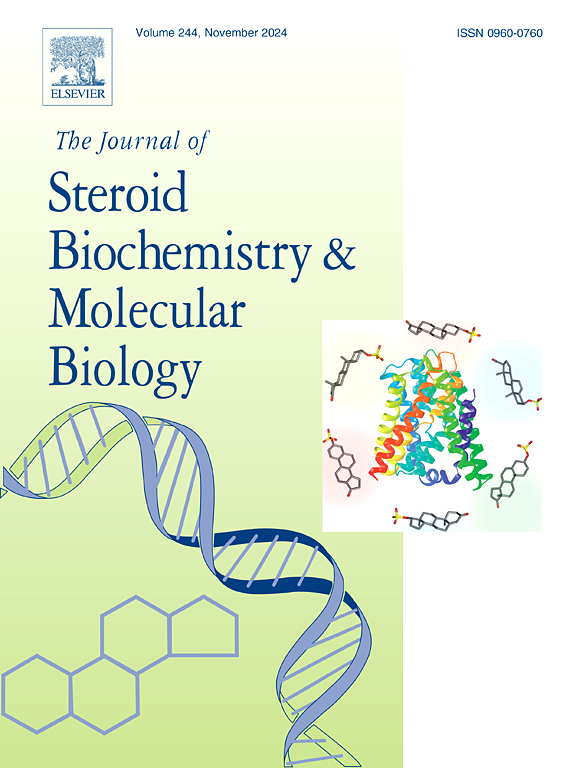2型糖尿病中DDB2的缺失导致脂质代谢紊乱的KMT2A泛素化失调。
IF 2.7
2区 生物学
Q3 BIOCHEMISTRY & MOLECULAR BIOLOGY
Journal of Steroid Biochemistry and Molecular Biology
Pub Date : 2025-01-09
DOI:10.1016/j.jsbmb.2025.106673
引用次数: 0
摘要
糖脂代谢紊乱会导致严重的疾病,包括心血管疾病、糖尿病和脂肪肝。在这里,我们发现DNA损伤结合蛋白2 (DDB2),一种E3泛素连接酶,是II型糖尿病(T2DM)脂质代谢紊乱的关键调节因子。建立小鼠T2DM模型和小鼠原代肝细胞脂肪变性模型。将DDB2过表达或与赖氨酸n -甲基转移酶2A (KMT2A)过表达载体联合递送至db/db小鼠和体外肝细胞。在db/db小鼠的肝组织和原代肝细胞中,DDB2高表达,KMT2A低表达。DDB2改善了葡萄糖耐受不良和胰岛素抵抗,降低了肝/体重比,下调了肝组织和细胞中脂肪生成相关蛋白(SREBP1、FASN和SCD1)和糖异生相关蛋白(PEPCK和G6Pase)的表达,降低了脂肪变性肝细胞中的甘油三酯和总胆固醇水平。DDB2通过泛素化修饰降低KMT2A的表达。过表达KMT2A可促进葡萄糖耐受不良,减轻胰岛素抵抗,同时促进脂肪生成和脂质沉积,抑制DDB2存在下的糖原积累。总体而言,我们的数据表明,DDB2通过降解KMT2A减轻肝脏脂肪生成和脂质沉积,从而抑制T2DM的脂质代谢紊乱。本文章由计算机程序翻译,如有差异,请以英文原文为准。
Loss of DDB2 in type II diabetes mellitus induces dysregulated ubiquitination of KMT2A in lipid metabolism disorders
The disorders of glucose and lipid metabolism contribute to severe diseases, including cardiovascular disease, diabetes, and fatty liver. Here, we identified DNA damage-binding protein 2 (DDB2), an E3 ubiquitin ligase, as a pivotal regulator of lipid metabolism disorders in type II diabetes mellitus (T2DM). A mouse model of T2DM and primary mouse hepatocytes with steatosis were induced. DDB2 overexpression alone or in combination with lysine N-methyltransferase 2 A (KMT2A) overexpression vectors were delivered into db/db mice and in vitro hepatocytes. DDB2 was expressed poorly, while KMT2A was expressed highly in liver tissues and primary hepatocytes of db/db mice. DDB2 ameliorated glucose intolerance and insulin resistance, decreased liver/body weight ratio, downregulated expression of lipogenesis-associated proteins (SREBP1, FASN, and SCD1) and gluconeogenesis-related proteins (PEPCK and G6Pase) in liver tissues and cells, and decreased triglyceride and total cholesterol levels in steatotic hepatocytes. DDB2 reduced KMT2A expression through ubiquitination modification. Overexpression of KMT2A promoted insulin resistance, lipogenesis and lipid deposition, and glycogen accumulation in the presence of DDB2. Overall, our data demonstrate that DDB2 alleviates hepatic lipogenesis and lipid deposition via degradation of KMT2A, thereby repressing lipid metabolism disorders in T2DM.
求助全文
通过发布文献求助,成功后即可免费获取论文全文。
去求助
来源期刊
CiteScore
8.60
自引率
2.40%
发文量
113
审稿时长
46 days
期刊介绍:
The Journal of Steroid Biochemistry and Molecular Biology is devoted to new experimental and theoretical developments in areas related to steroids including vitamin D, lipids and their metabolomics. The Journal publishes a variety of contributions, including original articles, general and focused reviews, and rapid communications (brief articles of particular interest and clear novelty). Selected cutting-edge topics will be addressed in Special Issues managed by Guest Editors. Special Issues will contain both commissioned reviews and original research papers to provide comprehensive coverage of specific topics, and all submissions will undergo rigorous peer-review prior to publication.

 求助内容:
求助内容: 应助结果提醒方式:
应助结果提醒方式:


